

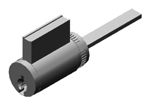 Refers to the type of cylinder used with several types of multi-point lock sets. These cylinders are attached to the escutcheon and do not vary in length, but the tailpiece length varies according to door thickness.
Refers to the type of cylinder used with several types of multi-point lock sets. These cylinders are attached to the escutcheon and do not vary in length, but the tailpiece length varies according to door thickness.
The dimension measured from the outside edge of the door to the center of the handle hub. Standard lengths for spring latches, privacy bolts, patio bolts and dead bolts: 2 3/8″ & 2 3/4″ and for all mortise cases: 2 1/2″ & 2 3/4″. (Custom backset lengths available.)
Bronze is a metal alloy that has been used for casting objects for centuries. At Rocky Mountain Hardware, we cast in two different bronze alloys – silicon bronze which produces gold undertones, and white bronze which produces silvery/pewter undertones.
Hinges with one leaf mortised to the jamb and one leaf mortised to the edge of the door.
The back plate behind a cabinet knob or pull.
For products like cabinet pulls or grips, the measurement between two attachment points.
Decorative nails typically applied to the surface of a door.
A portion of a lock where the key is inserted to lock or unlock the set. There are several different kinds common to Rocky Mountain Hardware sets.
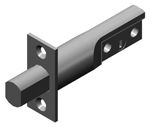 A locking mechanism that is separate from the latching mechanism in a door set. A dead bolt can be locked by a key or a turn piece. Rocky Mountain Hardware can provide separate dead bolt trim that is used above a handle set or can incorporate the dead bolt and handle trim onto the same escutcheon.
A locking mechanism that is separate from the latching mechanism in a door set. A dead bolt can be locked by a key or a turn piece. Rocky Mountain Hardware can provide separate dead bolt trim that is used above a handle set or can incorporate the dead bolt and handle trim onto the same escutcheon.
This is a set with inoperable handles on both sides of the door (typically in conjunction with roller catches, flush bolts or surface bolts).
This is a set with an inoperable handle on one side of the door (typically in conjunction with roller catches, flush bolts or surface bolts).
Used to retrieve a pocket door from the pocket.
This term refers to the capability of a lock to be unlocked from the exterior side in case of an emergency situation. This is an aspect of most interior privacy lock sets. Rocky Mountain Hardware provides an emergency release key with our privacy lock sets.
This is a locking set with operable handles that has a keyed cylinder on both sides of the door (typically used on primary exterior doors).
This is a locking set with operable handles that has a keyed cylinder on the exterior side of the door and a turn piece on the interior side (typically used on primary exterior doors).
Back plate that attaches to the door or to the ceiling/wall for lighting.
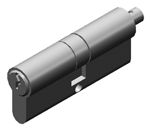 The other type of cylinder used with multi-point lock sets. These cylinders slip through the exterior escutcheon, the door and the interior escutcheon and are held in place by a set screw through the edge of the lock and vary in length for different door thicknesses.
The other type of cylinder used with multi-point lock sets. These cylinders slip through the exterior escutcheon, the door and the interior escutcheon and are held in place by a set screw through the edge of the lock and vary in length for different door thicknesses.
Recessed pulls used on sliding doors such as pocket or bypass doors.
Indicates where the door is hinged and the direction it swings.
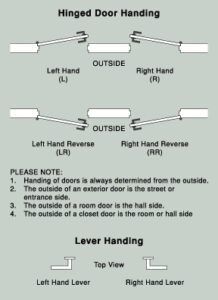
The portion of the set you grab to pull or rotate. The handle options are grips, levers, knobs or ring pulls.
The secondary door in a pair of doors. The inactive door is often secured with flush or surface bolts and typically has inoperable handles.
This is the portion of the set operated by the handles, cylinders, thumb latches and turn pieces.
This is the portion of the set usually attached to the surface of the door that consists of Escutcheon, Handle, Swing Cover, Thumb Piece and Turn Piece.
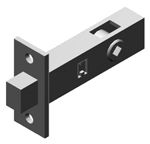 A locking mechanism that is separate from the latching mechanism and is operated by a turn piece. It is commonly used for interior applications to provide privacy on bedroom and bathroom doors.
A locking mechanism that is separate from the latching mechanism and is operated by a turn piece. It is commonly used for interior applications to provide privacy on bedroom and bathroom doors.
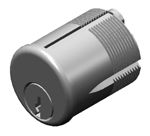 Mechanisms that are threaded into mortise locks, secured by a set screw through the edge of the lock and vary in length for different door thicknesses.
Mechanisms that are threaded into mortise locks, secured by a set screw through the edge of the lock and vary in length for different door thicknesses.
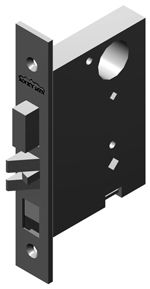 This mechanism integrates the locking and latching mechanisms into a single cartridge style lock. The mortise lock is available in a variety of functions such as entry, patio, privacy and passage.
This mechanism integrates the locking and latching mechanisms into a single cartridge style lock. The mortise lock is available in a variety of functions such as entry, patio, privacy and passage.
Mechanisms that latch the door at several points along the length of the door instead of a single point in close proximity to the handle. Multi-point locks are provided with French doors made by most of the major window manufacturers. Due to the variety of multi-point sets available, Rocky Mountain Hardware recommends that a copy of the existing lock trim or a factory drawing be sent to us so our trim can be machined correctly to match the lock in the door.
A decorative piece of metal applied to the surface of a door to mimic a strap hinge.
This is a non-locking set with operable handles (typically used on doors that do not require security or privacy such as closets, laundry or utility rooms, pantry, mechanical rooms and so on).
The bronze’s patina is a living finish that develops as the product ages. During production, the bronze is enhanced through an element bath. Touch, climate, and weather exposure will continue to change the bronze’s color, sheen, and texture.
This is a lock set with operable handles that is locked by a turn piece from the interior side, but has no keyed access from the exterior (typically used on secondary exterior doors).
This is a locking set with operable handles that is locked by a turn piece from the interior side and can be unlocked by an emergency release key from the exterior side (typically used on bedroom and bathroom doors).
This is a locking set with operable handles that is locked by a push button on the escutcheon from the interior side of the door and can be unlocked by an emergency release key from the exterior side (typically used on bedroom and bathroom doors).
This is a set with inoperable grip handles and/or escutcheons. The set can have locking capacity in single cylinder, double cylinder or patio applications and is available in full or single dummy as well (typically used for commercial applications).
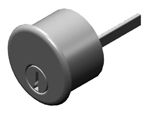 Mechanisms used in dead bolts that are mounted with screws from the opposite side of the door. They do not vary in length, but the mounting screw and tailpiece lengths vary according to door thickness.
Mechanisms used in dead bolts that are mounted with screws from the opposite side of the door. They do not vary in length, but the mounting screw and tailpiece lengths vary according to door thickness.
Each handle Rocky Mountain Hardware produces has an additional spring attached to the handle and the escutcheon that returns the lever, knob or ring to the neutral position; this mechanism eliminates sagging handles.
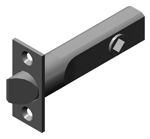 A latching mechanism operated by the handles.
A latching mechanism operated by the handles.
Hinges that have one leaf applied to the surface of the jamb and one leaf attached to the surface of the door.
The flap that covers the cylinder or the emergency release access.
This piece retracts the latch bolt on a thumb latch entry lock set.
This piece operates the dead bolt on the interior side of a locking set.